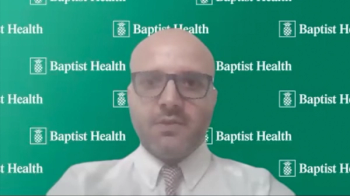
Oncology NEWS International
- Oncology NEWS International Vol 7 No 7
- Volume 7
- Issue 7
Disease Management Avoids Fragmented Patient Care
PASADENA, California--The health care system in the United States has been developed along the lines of medical specialization, which can lead to the fragmentation of patient care. Specialties are created by artificial divisions such as organ systems (cardiology, neurology); age (pediatrics, geriatrics); sex (urology, gynecology); disease (oncology); and function (surgery, obstetrics).
PASADENA, California--The health care system in the United States has been developed along the lines of medical specialization, which can lead to the fragmentation of patient care. Specialties are created by artificial divisions such as organ systems (cardiology, neurology); age (pediatrics, geriatrics); sex (urology, gynecology); disease (oncology); and function (surgery, obstetrics).
"Disease management attempts to transcend all these specialties by providing a structure for appropriate, high-quality, yet cost-effective care--often for patients with significant medical problems," said Albert E. Barnett, MD, former chairman, Friendly Hills Health Care Network, La Habra, California, at a seminar sponsored by the National Managed Health Care Congress.
Friendly Hills Health Care Network is a large integrated health care delivery system that approached disease management with the goal of preventing further fragmentation of patient care. Integrated internal services were used where possible, and carveouts, or contracted specialized services, were used "where they made sense," said Dr. Barnett, who is currently chairman of the Institute for Healthcare Advancement, Whittier, California.
Southern California Permanente Medical Group, Pasadena, a group-model HMO, with a 100% capitated system, approaches disease management differently. Oliver Goldsmith, MD, medical director and chairman of the board, described the Kaiser Permanente model as a "fixed system" in which nearly all care is provided internally.
Continuum of Care Model
At Friendly Hills Health Care Network, a continuum of care model was used to develop an integrated organizational system of medical care to meet its members needs. The continuum covered a variety of health care settings, including primary, ambulatory, acute, tertiary, home, long-term, and hospice. Case managers determined which care setting was most appropriate for patients.
In terms of disease management, Dr. Barnett said, services were provided by group members when possible and by outside groups in some cases.
"We looked at disease management in terms of carveouts," he said. "Carveouts were disease processes that were best moved out of the group practice, where care could be provided more efficiently and with higher quality."
Dr. Barnett described characteristics necessary for a successful carveout. First, it should be a well-defined specialty. Oncology is an example of such a specialty, since a patient either has cancer or does not. On the other hand, it is harder to develop specific guidelines for referral of patients to orthopedic specialists, for example.
A specialty area is also a good candidate for carveout if it produces manageable, and understandable, results and data. In addition, economic realities, like the need for specialized equipment and personnel, must be considered. Finally, a plan should determine the size of the patient base needed to make it worthwhile to provide the specialty care internally.
Oncology a Successful Carveout
At Friendly Hills, services that fulfilled these requirements and were successfully carved out were oncology, infectious disease treatment, neurosurgery, and mental health services.
A cardiology carveout was not as successful, Dr. Barnett said. Although cardiology is a very complex area, he said that referrals to cardiologists were appropriately managed. However, it was difficult to develop guidelines for expensive outsourced services, such as defining the appropriate number of surgeries, bypasses, angiograms, and echocardiograms needed by the patient population. Eventually, to better control utilization, the Friendly Hills group decided to establish an internal cardiology group.
A diabetes clinic was established but disbanded when it became too costly. Since these patients typically have multiple medical problems, the requirement to attend the diabetes clinic actually increased office visits.
These experiences led to a refined approach. "Rather than try to outsource whole specialties, or diseases that worked in the group practice modality, we outsourced specific processes," Dr. Barnett explained. Examples included coumadin and cholesterol clinics, run by pharmacists; a wound care clinic, run by nurses; and chiropractic services.
No Carveouts at Kaiser Permanente
Kaiser Permanentes organizational structure requires a different approach to disease management, Dr. Goldsmith said. Since Permanente physicians and the health plan have a mutually exclusive relationship, 98% of patient care in the California HMO is provided by its own medical personnel. The group-model employment structure provides a built-in integration of services, and therefore carveouts are not utilized, Dr. Goldsmith explained.
Disease management is one of the processes Kaiser Permanente uses to meet patient care performance goals, or targets. Rather than trying to get the 3,000 physicians in the Southern California Permanente Medical Group moving in a similar direction through the use of patient care guidelines, the Group uses internal targets, or measures of performance, that physicians continuously strive to meet.
Dr. Goldsmith noted that physicians have been found to respond very well to target setting. Deciding what to target, however, can be a challenge. "You want to target something that will make a difference," Dr. Goldsmith said. In addition, targets can be driven by various interested parties, for example, purchasers, members, or physicians.
To keep the improvement effort in motion, it is important to achieve the right mix of consensus on the development of targets and to utilize a regional management-driven push, Dr. Goldsmith commented. Goals should be kept realistic or participation in the efforts will decrease, he added.
Mitigating factors for the attainment of goals must be taken into account as well. Available technology, information system resources, membership growth, and the addition of new physicians to the system will influence the ability to meet targets.
Sometimes creative methods are necessary to move closer to a goal. For example, Dr. Goldsmith noted that even though physicians were recommending mammograms to patients, mammography rates were not increasing at a satisfactory rate.
A system was implemented that flags the medical record of a member who needs a mammogram. When that woman is seen for any medical service, the staff will be prompted to remind her that she needs the test. The member can then be scheduled for the mammogram within a very short time frame. "Once we did this, we saw a very satisfying rise in our mammography rates," he said.
The process of setting targets provides continuous improvements that benefit members, Dr. Goldsmith said. "Year after year, you can see measurable, objective improvements. The absolute numbers are not as important as continually improving the organizations performance," he said.
Articles in this issue
over 27 years ago
Calling the National Cancer Instituteover 27 years ago
Six Cycles of AT Found Safe in Advanced Breast Cancerover 27 years ago
New Drug Promising in Advanced Pancreatic Cancerover 27 years ago
Herceptin/Chemo Effective in Metastatic Breast Cancerover 27 years ago
Virtual Reality Exhibit Simulates Cancer Fatigueover 27 years ago
New Director of AIDS Researchover 27 years ago
Exhibit Explores Healing Power of Creating Artworkover 27 years ago
Update on Trials of Thrombopoietin for Platelet Recoveryover 27 years ago
Amifostine Reduces Xerostomia After RT for Head and Neck Cancerover 27 years ago
National Survey Documents Gap in Quality of HIV/AIDS CareNewsletter
Stay up to date on recent advances in the multidisciplinary approach to cancer.



















































































